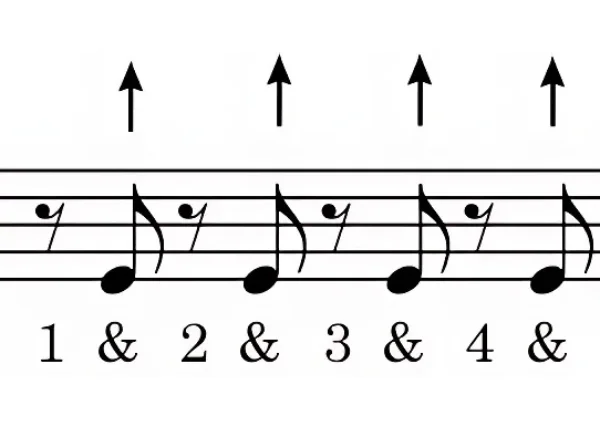You are so happy playing the tune of your favourite songs on ukulele and you want to level up by playing ukulele strumming pattern that sounds rhythmic while you sing or jam with fellow musicians, then mastering basic ukulele strumming patterns is the key to generating a rhythmic and energetic sound.. After you hold a chord shape with your left hand (non-dominant hand), you can play around and strum in the right hand (dominant hand) to check what goes well with the song that you are performing! Crazy right? And once you get the time signature and rhythm of a song, you can strum and sing any song that you like! Here in this article, I will share with you some of the most common and easy ukulele strumming pattern that you can try. So, choose a song you want to sing or perform, get the chords and let’s strum!
Relationship Between Musical Notes and Strumming
Before we dive into basic ukulele strumming patterns, it is important to understand a little about the correlation of notes with strumming. First thing to note before you choose a strumming pattern is to know the time signature of a song. The most common strumming patterns are generally denoted by the combination of Downs, Ups (Downstrokes, Upstrokes). So, if you have only quarter notes, you can just down strum. If you have eighth notes (which divides a beat by 2) you have to play Down up for that particular beat. The following images will help you to understand the analogy.


Similarly, if there are rest notes you can stop strumming. If you are a complete beginner, you can just play down strums for all the chord transitions. Then you can play even strumming of Down-Up strums. Once you get a hold of, progress to other ukulele strumming for beginners mentioned further.
Quick Tip!
When you are starting out to strum, use your thumb or index finger or both for strumming.
The following are some of the beginner friendly ukulele strums. Here, all the strumming patterns are given in 4/4 time signature.
DU-DU-DU-DU Strum
This is a easy ukulele strumming pattern in 4/4 time signature where all you need to do is to play even strumming of DU strums. You can use this in songs of any genre. An example of a song where you can play this strum is Hey jude by the beatles.

Island Strum (D-DU-UDU)
The most common strumming pattern that you can often incorporate in any of your songs which are in 4/4 time signature is called island strum. This strumming pattern is also called Hawaiian strum because of its origin. Island strum sounds cheerful, happy and vibrant. You can use this strum for most of the rock,pop,country songs. The 3rd beat is syncopated and hence you play only ‘&’ of 3&. An example of a song where you can play this strum is top of the world by the carpenters

D-D-DU-DU Strum
This is another combination of down, up strums. An example of a song where you can use this pattern is Hey soul sister by train. It’s great for mastering the 4/4 strumming pattern ukulele rhythm.

Swing Strum (-U-U-U-U)
This strum is commonly used in jazz, blues, and reggae music. It can also be called a reggae ukulele strumming pattern. Here the notes on the off beats are emphasised. You can use this pattern in three little birds by Bob Marley.

How To Choose A Strumming Pattern
Now that with so many options for strumming, it is quite normal to get confused on choosing a strumming pattern. The following ways will help you out to choose the appropriate strumming pattern for your song.
- Download/look for the sheet music of a song or ukulele tab this will help you with the chords, time signature, mood of the song. You can choose a strumming pattern according to the feel of the song.
- You can also choose a strumming pattern depending on the genre of the song that you have chosen
- While listening to the song, you can tap/clap along with the song, this will give you an idea on tempo and you can choose a pattern that goes well with the song.
Practicing The Strum
Start with any basic ukulele strumming patterns mentioned above. Keep the metronome on while you are practicing and try to speak out the pattern that you are playing till your hands get the strength and the pattern becomes a muscle memory. Keep a slower tempo and gradually you can increase the tempo in accordance. Also, Choose a song where the chord changes aren’t quick. Once you get a hold on strumming, you can focus on quick chord progressions and strumming accordingly.
Strumming In Other Time Signatures
While the focus here is on 4/4 strumming pattern ukulele, You can use a similar combination of down, up strums in other time signatures as well. Also, if the song is in waltz, you can play ¾ time signature as default.
Level Up Your Strum
Now that you’ve explored these basic ukulele strumming patterns, I hope you would have started experimenting out by playing any or all of the strumming patterns mentioned in this and if you want to explore more you can try the following techniques. The first technique that you can do is chuck (muted strum). So, chucking on the ukulele means you need to stop the downstrum. That is, you play the downstrum and mute it towards the end. This gives a very nice percussive feeling on the ukulele. When you are reading the ukulele tabs, chucking is given by a cross(X). You can also add staccato in your reggae pattern and make it interesting. You can also try advanced strumming like 8 finger roll where you use all the except the thumb to create a drum roll. This technique is more used in flamenco technique which is mostly heard in Spanish music. The possibilities are endless.
FAQs
How to improve ukulele strumming?
Choose the posture, relax and always play with the metronome on till you get the flow. You can also hum or sing along with the pattern that you are strumming in your ukulele.
What is the easiest strumming pattern for ukulele?
Basic down strums, D-U-D-U strums, island strums are easy and you can apply them to most of the songs.
How to strum and sing at the same time on ukulele?
Start by playing easy one finger chords and choose a song where there are only 2 or 3 chords. Try to hum and play the pattern. Be mindful of the shift in the chords. Keep doing it until it becomes easy.
What are the basic ukulele strumming patterns?
Some of the basic ukulele strumming patterns are reggae strum, island strum, simple down strums.
How to strum a ukulele for beginners?
Keep your hands relaxed and in position. When you strum, your index finger should be slightly curved. Strum with your fingernail for downstrokes and the fingertip for upstrokes across the strings near the soundhole.
What is the 4/4 strumming pattern on ukulele?
In 4/4 time signature, you have to ensure the strumming pattern and the beats per bar should match according to the time signature. When you choose a 4/4 strumming pattern on ukulele, you have to choose which beat to be emphasised and play down beat strongly while up beats should be lighter.
How to strum a ukulele like a pro?
To strum like a pro you should do the following,
- Practice strumming different patterns at varied speeds with the help of the metronome.
- Try singing with the strumming
- Choose finger position and choice of the fingers in accordance to the strumming pattern that you choose.
- Be mindful of the sound that you hear while you strum. You can also use a pick to strum
What are some popular ukulele strumming patterns?
Some popular strums are Hawaiian strum, island strum, riptide strum, classic strum, reggae strum. You can also mute the strings between strokes.
Related Blog: Ukulele Fretboard Note
































